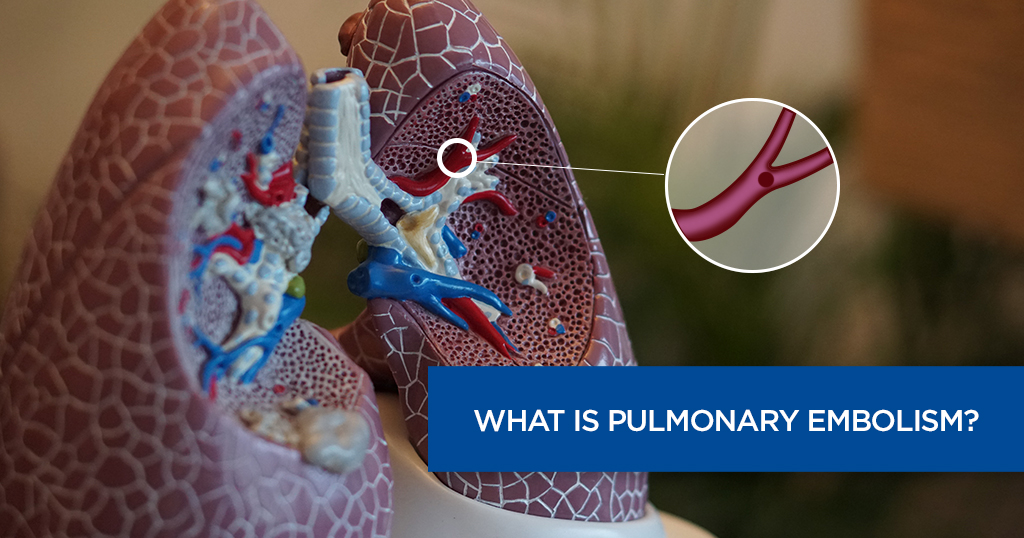What Is Pulmonary Embolism?


When a blood clot blocks one of the arteries in your lung and prevents proper blood circulation, this condition is Pulmonary Embolism or PE.
Pulmonary Embolism – About the Disease
Your heart (right side) pumps oxygen-poor blood to your lungs via the pulmonary artery. The lungs supply oxygen to your blood, which flows back to the heart. From there, the oxygen-rich blood circulates throughout your body. When a blood clot gets stuck in one of the Pulmonary arteries , it blocks normal blood flow, and this blockage is known as Pulmonary Embolism.
In most cases, this condition arises from a blood clot that gets loose from deep vein thrombosis (DVT) in the veins in the lower limbs of your body.
As these clots prevent the normal flow of blood to the lungs, this health condition can be life-threatening. However, immediate medical assistance can help a great deal to reduce the chances of death.
These blood clots appear when some conditions restrict or slow down blood circulation in the body . The conditions include –
- Being bedridden after an injury or surgery
- Sitting in the same position for a long time (during long drives and flights)
The Symptoms of Pulmonary Embolism
The signs and symptoms of pulmonary embolism can differ from one person to the other. It mainly depends on the following factors –
- The size of the blood clot
- If or not you are suffering from a heart or lung disease
- The portion of your lungs affected
Some of the common symptoms include the following –
- Chest pain – You feel heaviness in your lungs that might resemble a heart attack. There might be shooting pain in your chest, especially on taking deep breaths. The situation might worsen when you cough and lean on something.
- Shortness of breath – You might feel that you are gasping for air all of a sudden. It can get worse after doing a strenuous activity.
- Cough – You might see blood-tinged sputum after coughing.
Other symptoms of PE include –
- Excessive sweating
- Irregular or fast heartbeat
- Dizziness
- Fever
- Swelling in legs and calf
- Pain in the legs
- Discolored skin or bluish skin (cyanosis)
- Chest Pain
- Hemoptysis
When to Seeking Medical Help for Pulmonary Embolism
The signs and symptoms of PE can appear all of a sudden. Therefore, it is a medical emergency. Go to your doctor immediately if you experience chest pain, shortness of breath, bloody sputum with the cough.
Book an Appointment : Best Pulmonologist In India
Call 1860-500-1066 to book an appointment.
The Causes of Pulmonary Embolism
The most common cause of PE is a blocked artery. In some cases of pulmonary embolism, there might be multiple blood clots involved. If this happens, a portion of the lung tissue dies due to insufficient blood supply. This condition is pulmonary infarction.
In most of the cases, a blood clot that develops due to DVT (deep vein thrombosis) gets loose and makes its way to the pulmonary artery and blocks it. However, occasionally, there may be other substances blocking the blood vessels, apart from blood clots. It includes –
- Air bubbles
- Tumors
- Fat
- Amniotic fluid
Also Read About: Blood Clot in the Brain
Risk Factors Associated with Pulmonary Embolism
Pulmonary embolism can affect anyone, regardless of age and gender. However, some factors are more likely to put you at risk, including –
Family history
- Your risk of developing blood clots leading to PE is likely to be on the higher side if you have a family history of venous blood clots.
Diseases and treatments
Besides family history, certain health conditions and treatments also increase your risk. It includes –
- Cardiovascular (heart) disease – Especially heart failure increases the chances of blood clot formation.
- Kidney disease and inherited disorders – If you are suffering from kidney disease or you have an inherited condition, you are likely to be at risk.
- Cancer – Some cancers, including ovarian, breast, pancreatic, colon, brain, kidney, and lung cancer, or cancers that have metastasized or spread, can also put you at risk.
- Surgery – Undergoing a surgical procedure increases your chances of developing blood clots. Therefore, doctors prescribe clot-preventing medications before or after a critical process.
- Covid 19 infection – In severe cases , it can increase blood coagulability and increase the risk of PE.
Being immobilized for a prolonged time
- If you have been bedridden for a long time after an accident, surgery, trauma, or illness, it can hamper blood circulation resulting in blood clots.
- Sitting in an uncomfortable position during long road trips and flights can slow down blood circulation in your legs. It can lead to the formation of clots.
Other risk factors
- Pregnancy
- Smoking
- Obesity or being overweight
- Birth control pills(OCP)
Understanding the Complications of Pulmonary Embolism
According to statistics, nearly 1/3rd of patients with untreated or unidentified PE are less likely to survive. However, timely medical intervention save life.
In some cases, people suffering from PE can also get pulmonary hypertension. In the latter condition, the blood pressure in the heart (right side) and lungs becomes very high. With blockages in your pulmonary artery, your heart needs to pump harder to circulate the blood.
Rarely, small emboli can become recurrent. It can lead to chronic thromboembolic pulmonary hypertension or chronic pulmonary hypertension.
Diagnosing Pulmonary Embolism
Diagnosing PE can be difficult for people who are suffering from a lung or heart condition. Therefore, your doctor will take your family history (medical), do a physical check-up, and ask you to take the following tests (one or more) –
1. Blood examination
- Your doctor is more likely to order a D dimer (clot-dissolving substance) test. A high level of this substance may indicate the presence of blood clots in your body, although other factors can also lead to high levels of D dimer.
- Your doctor can also order a test to measure the percentage of carbon dioxide and oxygen in your blood. A lower level of blood oxygen can suggest blood clots.
- He or she will also examine if or not you have a genetic blood-clotting condition.
- Chest X-ray
Although chest X-ray is less likely to diagnose this condition, it helps your doctor to rule out any other illness that might cause similar symptoms.
- Ultrasonography
A non-invasive test called duplex ultrasonography (sometimes known as compression ultrasonography or duplex scan) makes use of sound waves to scan the veins in your thigh, knee and calf, and sometimes in the arms, to check for deep vein blood clots.
4. CT pulmonary angiography
Also known as CT pulmonary embolism study, it helps your doctor to look for any abnormality in the blood vessels of your lungs by creating 3D images , using a contrast material to highlight the pulmonary arteries.
5. Ventilation-perfusion scan
In some cases, where the doctor cannot expose the patient to radiation or contrast material, a ventilation-perfusion scan may be done .
6. Pulmonary angiogram
It is one of the most reliable procedures to diagnose PE as it provides a clear picture of blood circulation in the blood vessels of your lungs.
- Magnetic resonance imaging or MRI
This test uses magnetic fields to create pictures of your organs and tissues.
Book an Appointment : Best Pulmonologist In India
Call 1860-500-1066 to book an appointment.
Various Treatment Options for Pulmonary Embolism
Your doctor will aim at preventing blood clot formation and keeping the size of the already formed blood clots in check.
Medicines
Your doctor is likely to provide you with the following medications –
- Anticoagulants or blood thinners – These medications prevent the enlargement of the existing clots and formation of new ones.
- Thrombolytics or clot dissolvers – These drugs liquefy blood clots quickly. However, these can lead to severe and abrupt bleeding. For this reason, these are the last-minute options and used for life-threatening scenarios.
Surgical procedures
- Vein filter – In case you cannot take blood thinners owing to a pre-existing condition, your doctor may implant a vein filter in the inferior vena cava (the major vein of your body). This vein connects the right side of your heart to your legs. Eventually, if you do not need the filter assistance, your doctor will remove it.
- Clot removal – In cases with big and life-threatening blood clots in the lung, the doctor may perform a clot removal procedure with the help of a catheter (a thin and flexible tube).
Preventive Measures for Pulmonary Embolism
The following are the preventive measures for pulmonary embolism –
- Compression stockings: The compression stockings squeezes your legs steadily, helping the veins and your leg muscles move blood more efficiently.
- Pneumatic compression: In the pneumatic compression treatment calf-high or thigh-high cuffs are used which inflate with air and deflate automatically every few minutes to massage and squeeze the veins in the legs and improve your blood flow.
- Anticoagulants or Blood thinners: Anticoagulants aregiven to prevent risk of clots before and after a surgery and in medical conditions like stroke, heart attack or cancer complications.
- Leg elevation: Elevating the legs whenever possible and during the night can also be very effective.
- Physical activity: Physically movingas soon as possible after the surgery can help prevent pulmonary embolism and accelerate overall recovery.
- Prevention while traveling
Talk to your doctor, if you have any risk factors for blood clots and are concerned about travel. Your doctor may suggest the following to help you prevent blood clots during your travel:
- Wear support stockings
- Fidget in your seat: Keep flexing ankles every 15 – 30 minutes
- Drink lot of fluids: Avoid alcohol, which contributes to loss of fluid. Water is the best fluid that helps prevent dehydration which may contribute to the development of blood clots.
- Take a break from sitting: If you are travelling long distances, take a break to move around once an hour or so. During air travel move around the airplane cabin, once an hour.
Conclusion
Pulmonary embolism can be deadly if ignored. If you notice any signs and symptoms of PE, it is important to consult with a doctor and receive proper treatment.
Book an Appointment : Best Pulmonologist In India
Call 1860-500-1066 to book an appointment.
© Copyright 2024. Apollo Hospitals Group. All Rights Reserved.
 +91 8069991061
Book Health Check-up
Book Health Check-up
Book Appointment
Book Appointment
+91 8069991061
Book Health Check-up
Book Health Check-up
Book Appointment
Book Appointment







